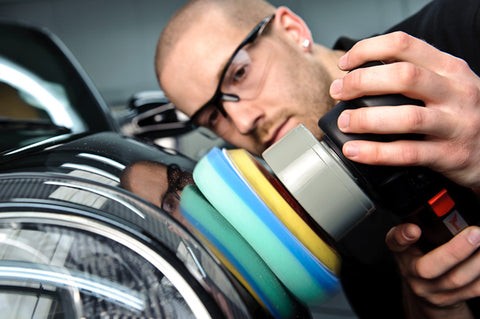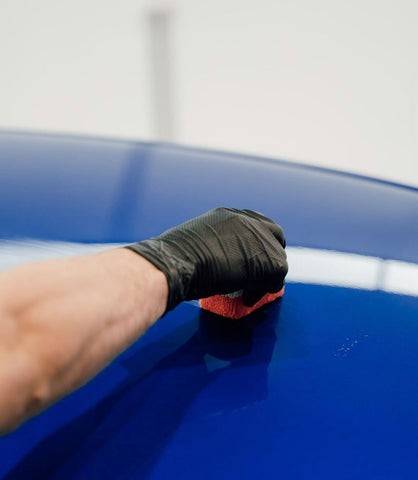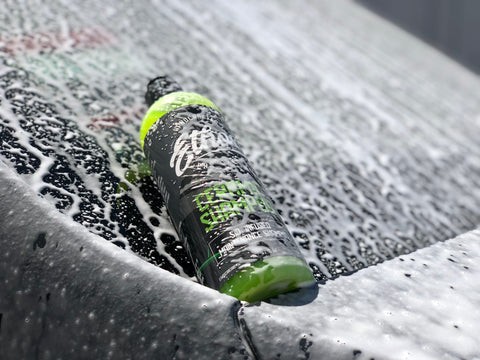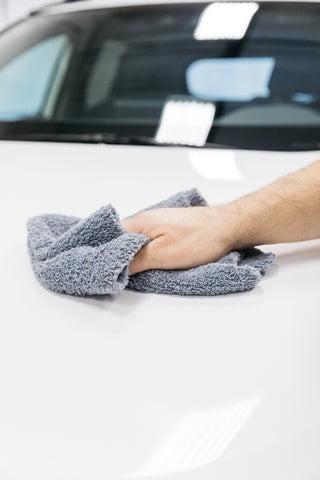Ceramic coating your car is the ultimate way to protect its paint and keep it looking its best, and CARS.EDU.VN is here to guide you through the entire process. This comprehensive guide will provide you with the knowledge and step-by-step instructions needed to achieve a professional-quality ceramic coating at home. Learn about paint protection, car detailing, and auto care with us.
1. Understanding Ceramic Coatings: The Science Behind the Shine
A ceramic coating is a liquid polymer applied to a vehicle’s exterior, creating a protective layer that bonds chemically with the factory paint. This layer shields the car from environmental contaminants, UV rays, and minor scratches, providing long-lasting protection and enhanced aesthetics. Unlike waxes or sealants, a ceramic coating forms a semi-permanent bond, offering years of protection with proper maintenance.
Ceramic coatings typically contain silica dioxide (SiO2), derived from quartz sand, and titanium dioxide (TiO2). These ingredients create a hard, transparent layer that enhances the paint’s gloss and provides excellent water beading properties, making the car easier to clean. According to a study by the International Car Detailing Association (ICDA), cars with ceramic coatings require less frequent washing and detailing, saving time and money in the long run.
1.1. Benefits of Ceramic Coating
Ceramic coatings offer a multitude of benefits, making them a popular choice among car enthusiasts and everyday drivers alike. Here are some key advantages:
- Long-lasting Protection: Ceramic coatings can last for several years, far longer than traditional waxes or sealants.
- Scratch Resistance: While not scratch-proof, ceramic coatings provide a layer of defense against minor scratches and swirl marks.
- UV Protection: The coating shields the paint from harmful UV rays, preventing fading and oxidation.
- Chemical Resistance: Ceramic coatings protect against acid rain, bird droppings, and other environmental contaminants.
- Hydrophobic Properties: The coating’s water-repellent properties make the car easier to clean and maintain.
- Enhanced Gloss: Ceramic coatings enhance the paint’s depth and gloss, giving the car a showroom-worthy shine.
1.2. Ceramic Coating vs. Wax and Sealants
While waxes and sealants offer some level of paint protection, they pale in comparison to ceramic coatings in terms of durability and performance. Waxes provide a temporary layer of protection that lasts for a few weeks or months, while sealants offer slightly longer protection, typically up to six months. Ceramic coatings, on the other hand, can last for several years with proper care.
| Feature | Wax | Sealant | Ceramic Coating |
|---|---|---|---|
| Durability | Weeks | Months | Years |
| Scratch Resistance | Minimal | Moderate | High |
| UV Protection | Low | Moderate | High |
| Chemical Resistance | Low | Moderate | High |
| Hydrophobic Properties | Moderate | High | Excellent |
| Gloss | Enhanced | Enhanced | Superior |
| Application | Frequent | Less Frequent | Infrequent |




As you can see, ceramic coatings offer superior protection and longevity compared to waxes and sealants. While the initial investment may be higher, the long-term benefits make it a worthwhile upgrade for any car owner.
2. Preparing Your Car for Ceramic Coating: The Key to Success
Proper preparation is crucial for achieving a flawless ceramic coating finish. This involves a multi-step process that includes washing, decontaminating, and polishing the paint to remove any imperfections.
2.1. Washing and Decontamination
The first step is to thoroughly wash the car to remove any dirt, grime, and loose contaminants. Use a pH-neutral car wash soap and a microfiber wash mitt to avoid scratching the paint. Rinse the car thoroughly and dry it with a clean microfiber towel.
After washing, it’s essential to decontaminate the paint to remove any embedded contaminants such as iron particles, tar, and tree sap. Use an iron remover spray and a clay bar or clay mitt to remove these contaminants. Iron removers dissolve iron particles, while clay bars physically remove embedded contaminants from the paint’s surface.
2.2. Paint Correction: Polishing for a Flawless Finish
Once the car is washed and decontaminated, it’s time to address any paint imperfections such as swirl marks, scratches, and oxidation. This is where paint correction comes in. Paint correction involves using a machine polisher and various polishing compounds to level the paint’s surface and remove imperfections.
Depending on the severity of the paint imperfections, you may need to use a multi-stage polishing process. This typically involves using a more aggressive compound to remove deeper scratches, followed by a finer polish to refine the finish and enhance gloss. Always start with the least aggressive approach and gradually increase the aggressiveness as needed.
2.3. Final Prep: Ensuring a Clean Surface
After polishing, it’s crucial to remove any polishing oils or residue from the paint’s surface. Use an isopropyl alcohol (IPA) solution or a dedicated panel wipe to clean the paint and ensure a pristine surface for the ceramic coating to bond to. This step is essential for proper coating adhesion and longevity.
3. Applying the Ceramic Coating: Step-by-Step Guide
With the car properly prepared, it’s time to apply the ceramic coating. This process requires patience, attention to detail, and a clean, well-lit environment.
3.1. Gathering Your Supplies
Before you begin, make sure you have all the necessary supplies on hand:
- Ceramic coating product
- Applicator pad
- Microfiber towels
- Gloves
- Work light
3.2. Application Process
- Apply the Coating: Shake the ceramic coating bottle well and apply a few drops to the applicator pad.
- Spread Evenly: Working in small sections (approximately 2′ x 2′), apply the coating to the paint in a crosshatch pattern, ensuring even coverage.
- Flash Time: Allow the coating to “flash” or cure for the recommended time specified in the product instructions. This is when the coating begins to bond to the paint and will appear slightly hazy.
- Level the Coating: Use a clean microfiber towel to gently wipe away any excess coating and level the surface.
- Inspect: Use a work light to inspect the surface for any streaks or high spots and buff them out with a clean microfiber towel.
- Repeat: Repeat the process on all painted surfaces of the car, including the hood, roof, doors, and trunk.
- Cure Time: Allow the coating to fully cure for the recommended time before exposing it to water or other elements. This can range from 24 to 72 hours, depending on the product.
3.3. Layering for Enhanced Protection
For added protection and durability, consider applying a second layer of ceramic coating. Follow the same application process as the first layer, ensuring that the first layer is fully cured before applying the second.
4. Maintaining Your Ceramic Coating: Keeping the Shine Alive
Proper maintenance is crucial for maximizing the lifespan and performance of your ceramic coating. This involves regular washing, avoiding harsh chemicals, and using appropriate cleaning products.
4.1. Washing Your Car
Wash your car regularly using a pH-neutral car wash soap and a microfiber wash mitt. Avoid using automatic car washes, as they can scratch the coating and reduce its lifespan. When drying the car, use a clean microfiber towel or a leaf blower to avoid water spots.
4.2. Avoiding Harsh Chemicals
Avoid using harsh chemicals, such as degreasers, solvents, and abrasive cleaners, on your ceramic coating. These chemicals can damage the coating and reduce its hydrophobic properties.
4.3. Using Ceramic-Infused Products
Use ceramic-infused detailing products, such as ceramic wash soaps, detail sprays, and toppers, to maintain the coating’s hydrophobic properties and enhance its gloss. These products contain SiO2 particles that bond to the coating and replenish its protective layer.
4.4. Addressing Water Spots
Water spots can be a common issue on ceramic-coated cars, especially in areas with hard water. To remove water spots, use a dedicated water spot remover or a diluted vinegar solution. Apply the product to the affected area, let it dwell for a few minutes, and then wipe it off with a clean microfiber towel.
5. Choosing the Right Ceramic Coating: Factors to Consider
With so many ceramic coating products on the market, it can be challenging to choose the right one for your needs. Here are some factors to consider when selecting a ceramic coating:
5.1. Durability
Consider the coating’s advertised durability. Some coatings are designed to last for a year or two, while others can last for five years or more. Choose a coating that meets your desired level of protection and longevity.
5.2. Hardness
The hardness of a ceramic coating is measured on the Mohs hardness scale. A higher hardness rating indicates greater scratch resistance. Look for coatings with a hardness rating of 9H for maximum protection.
5.3. Ease of Application
Some ceramic coatings are easier to apply than others. If you’re a beginner, look for a coating that is user-friendly and comes with clear instructions.
5.4. Price
Ceramic coatings range in price from affordable to high-end. Consider your budget and choose a coating that offers the best value for your money.
5.5. Brand Reputation
Choose a ceramic coating from a reputable brand with a proven track record of quality and performance. Read reviews and testimonials from other users to get an idea of the coating’s real-world performance.
6. Common Mistakes to Avoid When Applying Ceramic Coating
Applying a ceramic coating can be a rewarding experience, but it’s essential to avoid common mistakes that can compromise the coating’s performance and longevity. Here are some pitfalls to watch out for:
6.1. Skipping Prep Work
As mentioned earlier, proper preparation is crucial for a successful ceramic coating application. Skipping steps like washing, decontaminating, or polishing can result in poor coating adhesion and a subpar finish.
6.2. Applying Too Much Coating
Applying too much coating can result in streaks, high spots, and a hazy finish. Always apply a thin, even layer of coating and level it properly with a clean microfiber towel.
6.3. Not Wiping Off Excess Coating
Failing to wipe off excess coating within the recommended flash time can result in a sticky, uneven finish. Always wipe off excess coating promptly and thoroughly.
6.4. Applying in Direct Sunlight or Extreme Temperatures
Applying ceramic coating in direct sunlight or extreme temperatures can cause the coating to cure too quickly or unevenly, resulting in a compromised finish. Always apply the coating in a cool, shaded environment.
6.5. Not Wearing Gloves
Ceramic coatings can be irritating to the skin. Always wear gloves when handling the coating to protect your hands.
7. The Future of Ceramic Coatings: What’s Next?
The ceramic coating industry is constantly evolving, with new technologies and advancements emerging regularly. Here are some trends to watch out for in the future:
7.1. Graphene-Infused Coatings
Graphene is a single-layer sheet of carbon atoms that is incredibly strong, lightweight, and flexible. Graphene-infused ceramic coatings offer enhanced scratch resistance, durability, and hydrophobic properties compared to traditional ceramic coatings.
7.2. Self-Healing Coatings
Self-healing coatings are designed to repair minor scratches and swirl marks on their own. These coatings contain polymers that can flow and fill in imperfections when exposed to heat, restoring the coating’s original appearance.
7.3. UV-Curable Coatings
UV-curable coatings cure rapidly when exposed to ultraviolet light. This allows for faster application and reduced cure times, making them ideal for professional detailers.
8. Real-World Examples and Case Studies
To illustrate the benefits of ceramic coatings, let’s look at some real-world examples and case studies:
8.1. Protecting a Classic Car
A classic car owner wanted to protect his prized possession from the elements and preserve its original paint. He opted for a ceramic coating to shield the car from UV rays, acid rain, and other contaminants. The coating not only protected the paint but also enhanced its gloss, giving the car a showroom-worthy shine.
8.2. Maintaining a Daily Driver
A daily driver owner was tired of spending hours washing and waxing his car every weekend. He decided to try a ceramic coating to make his car easier to clean and maintain. The coating’s hydrophobic properties made washing the car a breeze, and the coating’s scratch resistance helped to minimize swirl marks from car washes.
8.3. Enhancing Resale Value
A car owner wanted to enhance the resale value of his vehicle before selling it. He invested in a ceramic coating to protect the paint and improve its appearance. The coating not only made the car look newer but also helped to protect it from damage during test drives and inspections.
9. Frequently Asked Questions (FAQs) About Ceramic Coatings
Here are some frequently asked questions about ceramic coatings:
- How long does a ceramic coating last?
- A ceramic coating can last anywhere from 1 to 5 years, depending on the product and maintenance.
- Can a ceramic coating prevent scratches?
- While not scratch-proof, a ceramic coating can provide a layer of defense against minor scratches and swirl marks.
- How do I maintain a ceramic coating?
- Wash your car regularly with a pH-neutral car wash soap and avoid harsh chemicals. Use ceramic-infused detailing products to maintain the coating’s hydrophobic properties.
- Can I apply a ceramic coating myself?
- Yes, you can apply a ceramic coating yourself, but it requires patience, attention to detail, and proper preparation.
- How much does a ceramic coating cost?
- The cost of a ceramic coating can range from a few hundred dollars for a DIY kit to several thousand dollars for professional installation.
- Does ceramic coating protect against rock chips?
- Ceramic coatings offer some protection against minor rock chips, but they are not as effective as paint protection film (PPF).
- Can I wax a ceramic-coated car?
- While you can wax a ceramic-coated car, it’s not necessary. Waxing can actually reduce the coating’s hydrophobic properties and lifespan.
- How often should I wash my ceramic-coated car?
- Wash your ceramic-coated car as needed, typically every 1-2 weeks.
- Can I use a pressure washer on a ceramic-coated car?
- Yes, you can use a pressure washer on a ceramic-coated car, but use a wide nozzle and keep a safe distance to avoid damaging the coating.
- What happens if a ceramic coating fails?
- If a ceramic coating fails, it may lose its hydrophobic properties, become dull, or develop water spots. In this case, you may need to reapply the coating.
10. CARS.EDU.VN: Your Ultimate Resource for Automotive Information and Services
At CARS.EDU.VN, we are dedicated to providing you with the most comprehensive and up-to-date information on all things automotive. Whether you’re looking for detailed guides on car care and maintenance, expert reviews of the latest models, or a directory of trusted repair shops and service providers, CARS.EDU.VN has you covered.
We understand that finding reliable automotive services can be a challenge. That’s why we’ve created a platform that connects you with top-rated professionals in your area. Our extensive database includes mechanics, detailers, body shops, and more, all vetted for quality and expertise.
Are you struggling to find reliable car repair services or lacking the knowledge for proper car maintenance? Do you need assistance in choosing the right car model or want to stay updated on the latest automotive technologies? Visit CARS.EDU.VN today for expert guidance and solutions!
Contact us:
- Address: 456 Auto Drive, Anytown, CA 90210, United States
- WhatsApp: +1 555-123-4567
- Website: CARS.EDU.VN
cars.edu.vn is committed to providing you with the information and resources you need to make informed decisions about your automotive needs. Explore our website today and discover a wealth of knowledge and services designed to enhance your car ownership experience. We’re here to help you keep your car looking its best and running smoothly for years to come.